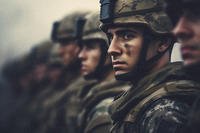Removing the flexed arm hang and adding pull-ups to the women's fitness standards in the Marine Corps was an upgrade that was considered carefully and studied and implemented with support throughout the chain of command for the past couple of years. However, recent events have forced the USMC to reconsider the start date of the new change. When 55% of the female graduating class at boot camp failed the three-pull-up minimum, the Jan. 1, 2014, implementation date was postponed.
Why is this an issue?
The Marine Corps made this an issue when they made the change. However, this is a societal problem that is dropped in the laps of our military each year. This is nothing new. Unfit candidates have been arriving at boot camps, basic training, police and fire academies for decades. From the late 1980s until now, the physical abilities of the average recruit have slowly declined -- or deteriorated may be a better word for it.
Now, the number one reason preventing an 18-year-old person from joining the military is that they fail to meet the height/weight standards. What happened to the good old days when the biggest obstacle to joining the military was a criminal record or failure to graduate high school?
The fact is that the United States is overweight and out of shape. The heavier you are, the harder it is to do pull-ups.
Whose problem is this?
The military did not create this problem, though the military is forced to deal with it. And even though 55% of the female recruits fail the new pull-up standard, they will meet and surpass the minimum standard with some practice (usually 4-6 months). Again, this is nothing new. The military had the same issue when they changed from knee push-ups to regular push-ups for women. Now regular push-ups are the standard in military and law enforcement.
Women and men can do pull-ups. Women and men can fail at doing pull-ups. This is a societal problem. Men and women have to keep their body weight down and practice pull-ups. This takes time. It is not uncommon for young men and women to take up to six months before they score their first pull-up.
But the common denominator to passing a pull-up test is to practice pull-ups. The USMC should keep pushing this standard; it will be met eventually.
The pull-up and combat debate
Many talking heads are equating the women's higher failure rate in pull-ups with a lack of ability to perform in combat. Combat roles should be tougher to enter and have higher fitness standards (for men and women) because the demands of combat arms/special operations are higher than any fitness test will prove.
The minimum physical standard should not be someone's fitness goal if seeking a combat arms specialty. One day, you will rely on your physical ability to save your own life or a fellow Marine in your unit. The reality is that not everyone in the military is in combat roles. There are cooks, computer technicians, intelligence specialists, logistics, admin/supply clerks, photographers and many more non-combat roles that men and women will fill in all branches of the military. The 45% of the women who not only meet the minimum standard but are doing 10+ pull-ups should have the opportunity to qualify for advanced training.
How do we address the combat/fitness role?
For years, advanced fitness tests have been used to prove your mettle in the Special Operations world. For instance, the regular Navy uses the push-ups, sit-ups and 1.5-mile run, but the Navy SEALs/EOD/diver community uses the 500-yard swim, pull-ups, push-ups, sit-ups and 1.5-mile run just to get into the six- to 12-month training program, which is the true test.
The regular Army has the push-ups, sit-ups and two-mile run, and the Rangers and Special Forces both add pull-ups, a five-mile run and a 12-mile ruck as part of their testing/evaluating of their potential combat troops. The Marines are tough, with the regular Marine having to do pull-ups, crunches and a three-mile run. This is by far the hardest regular military fitness test in the United States.
Perhaps, it is time to adjust the fitness test to combatant and non-combatant troops. If a Marine (man or woman) wants to be in a combat unit, the elevated standards apply -- everyone does pull-ups. If someone is in a non-combatant unit, flexed arm hangs are sufficient for men and women. One also must remember that just because you can do a pull-up does not make you a combat-ready troop.
The Infantry Schools, Special Forces Assessment and Selection (SFAS), Qualification Course, BUD/S, RECON/MARSOC and other combat training programs are the true test. Being able to do pull-ups will help you with your upper-body strength/grip to grab people and equipment, lift yourself and others from A to B, and up and over obstacles. The pull-up does not ensure your ability to graduate from these advanced courses of instruction.
How do we fix the fitness problem?
If we want to address and fix the bigger problem, we have to get children to maintain a healthy weight and practice pull-ups. Whether you are a boy or girl, you should start playing on playgrounds and start building your grip and pull-up muscles on the monkey bars. Moms and dads who watch their kids or coach on youth sports teams, make your team do pull-ups, push-ups and run regularly. Coaches and gym teachers in physical education class, add the inexpensive exercises of push-ups, sit-ups, running and pull-ups to your children's list of activities and start testing them now.
Like men who failed the pull-up test, the 55% of the women this article is about failed, not because of an unfair fitness standard increase, but because of lack of preparation and not taking advantage of the resources available to them. Girls should be raised with an expectation that pull-ups are well within their capabilities. As a society, we have to make fitness and health standards better known so that meeting these standards becomes the norm for men and women.
As of this article, the pull-up is not a requirement for female Marines.
Stew Smith is a former Navy SEAL and fitness author certified as a Strength and Conditioning Specialist (CSCS) with the National Strength and Conditioning Association. Visit his Fitness eBook store if you're looking to start a workout program to create a healthy lifestyle. Send your fitness questions to stew@stewsmith.com.
Want to Learn More About Military Life?
Whether you're thinking of joining the military, looking for fitness and basic training tips, or keeping up with military life and benefits, Military.com has you covered. Subscribe to Military.com to have military news, updates and resources delivered directly to your inbox.



















